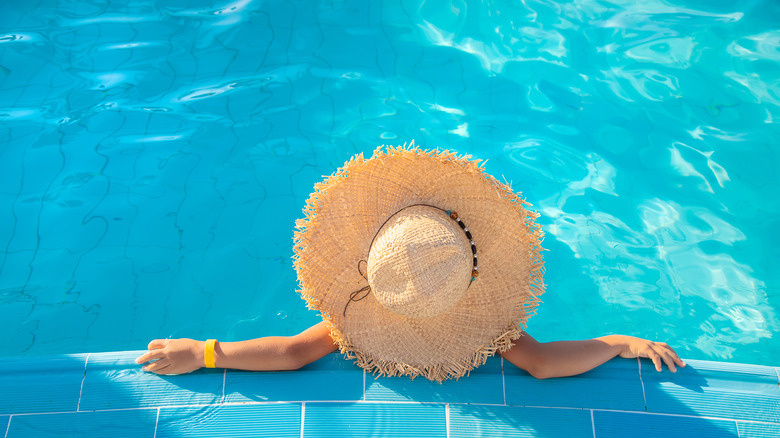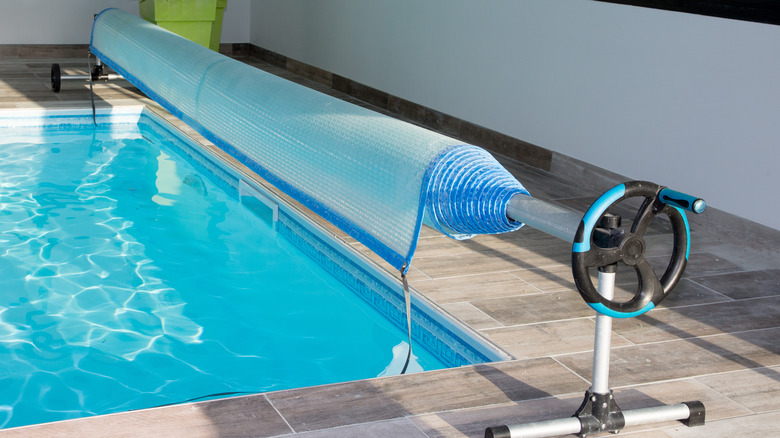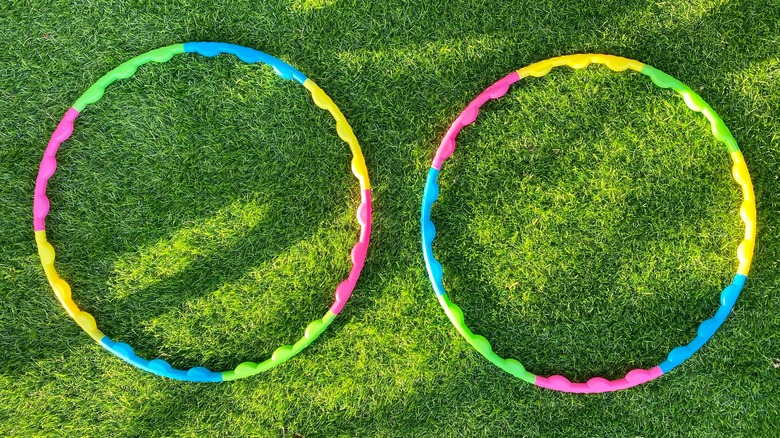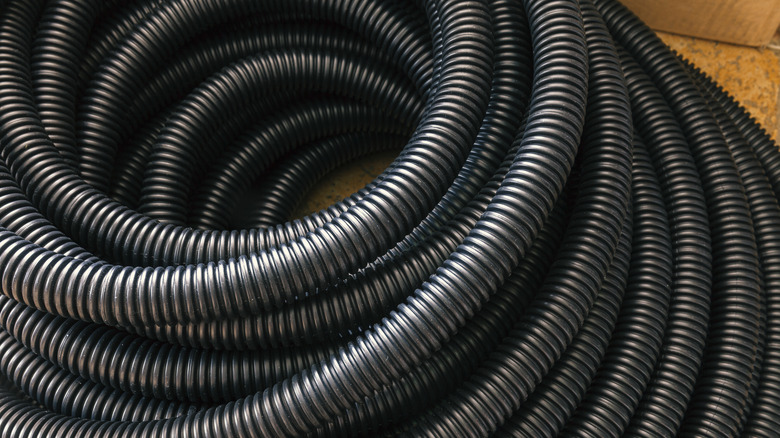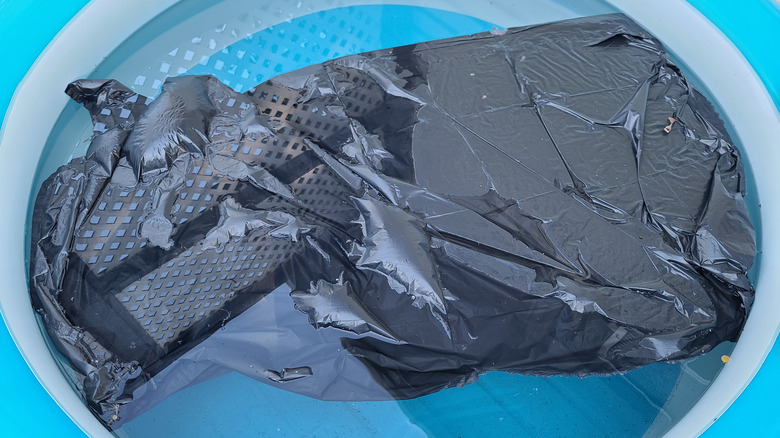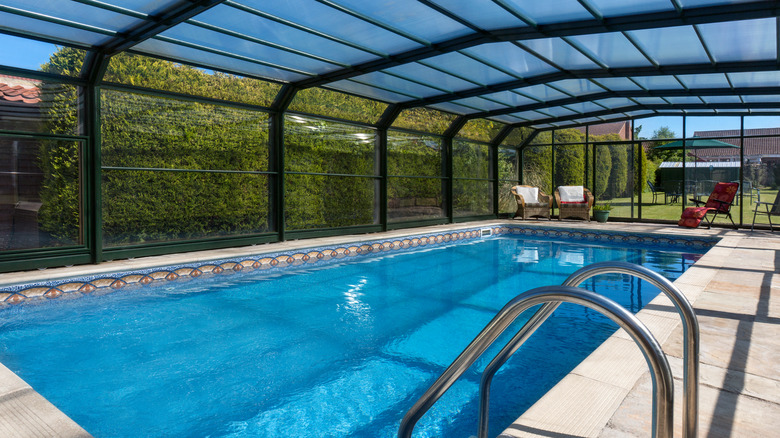7 Cheap Ways To Heat Your Pool
If you live in an area with seasonal changes, having a pool usually means you can have a blast during the warm months but have to keep it covered the rest of the year, but it doesn't have to be that way! Make pool days a year-round activity by having a heating method (or two) in your back pocket. Being able to heat your pool means more opportunities for social time and recreation. It also adds value to your home since the pool will be available for more months out of the year, according to Poolwerx.
Of these seven pool heating options, some are quick and temporary, while others are more complex, long-term solutions. Some options can be put in place within a day using minimal supplies and effort; others require professional help. The great thing is that with so many options, you won't have an issue finding something that fits your situation and needs.
1. Solar covers
The sun is an excellent pool heater because it is free and never runs out of power. However, there are some downsides. The heat from the sun only lasts during the day, and it causes the water to evaporate. This is where solar covers come in. These large plastic covers act as insulators for the sun's heat and prevent water and chemicals from evaporating, according to Swim University. You can get simple covers or thermal blankets. While the blankets are heavier and more expensive than the simple covers, they are more durable and better quality. Covers can cost around $150 to a little over $1,000; thermal blankets typically start at about $1,000 (via My Perfect Pool).
Solar covers can also come in liquid form. Liquid covers are made of fatty alcohols that form a thin layer on the pool water. These skin-safe chemicals make a convenient heat retainer because you can still use your pool while they go to work. Liquid covers are also easier to manage than solid covers, which can be a hassle to put on and take off. Both options are affordable, but liquid covers are typically cheaper. Still, solid covers are more effective at insulating the pool and protecting it from losing its water and chemicals, retaining about 25 percent more heat, per Swim University.
2. Solar rings
These are a great alternative to traditional solar covers because they work the same way but come in a smaller, more portable package. They cost less, are easier to take off and put on, and don't need to be custom-fitted to your pool. According to Medallion Energy, you should buy enough rings to cover the whole surface of your pool and make sure they have magnets so they can stay attached. Solar rings come in various styles, so you can find them in cool, fun designs. One thing to be aware of is that, unlike regular solar covers, they won't be completely effective in keeping out debris.
Interested in an even cheaper, DIY version of solar rings? Use hula hoops! Buy enough hula hoops to cover your pool and put some polyethylene film on them. Then, throw them in your pool, where they will draw in the sun's heat.
3. Heat pump
Heat pumps work by using the heat in the air to warm up the pool. They take the air from the atmosphere and circulate it. The air is transformed into a hot gas which then transfers heat onto the pool water, according to Madimack. An interesting thing about this process is that the transformation of hot air relies on the temperature outside instead of the actual presence of the sun, so they can keep your pool warm even on cloudy days, according to Medallion Energy.
Though heat pumps are more costly than covers, they can still be great if you're on a budget; some cost as little as a dollar to operate for a day since they don't require a ton of energy, per Madimack. They are a good option if you live in an area with warm weather or somewhere prone to cloudy days. They can work in a range of temperatures but are most effective when it is at least 40 degrees Fahrenheit. However, some more expensive heaters can work in temperatures as low as the mid-30s, according to Medallion Energy. Swim University estimates the cost of installing a heat pump to be between $500 and $1,500, while the monthly costs of operation could be from $100 to $200.
4. Black hose
This clever DIY hack works by using a garden hose to circulate warm water in your pool. According to the guide by Medallion Energy, you'll need to buy a black garden hose that can be plugged into your pool pump with at least 50 to 100 feet of extra length. Connect one end of the hose to the pool's pump return, make the rest of the hose into a large coil and leave it in an area with direct sunlight. Then, simply put the other end of the hose in your pool. With the majority of the hose being exposed to the sun in a coil formation, it will retain heat better and keep the pool warm.
This should cost you around $80 to $150, according to Medallion Energy. If you have a roof or deck close to your pool, they recommend placing coils on top for direct sun exposure.
5. Trash bags
For a true DIY hack, transform some black trash bags into lily pads for your pool (you'll need some hula hoops for this, too.) This Instructables guide lays out a simple process for cheaply heating your pool with trash bags.
Gather some foam pool noodles, duct tape or ties, and scissors. Put the hula hoop in the trash bag and tie it tightly with the duck tape or tie to seal it. Next, cut the noodles into four pieces, open them up by cutting vertically, and attach the pieces to your lily pad. Now, they will collect heat from the sun as they float in the pool. You can also ditch the hula hoops and place tied trash bags on the water by themselves, adds Bob Vila. Bob Vila recommends the extra thick, contractor-grade trash bags to achieve the best results. Plain, black plastic sheets will also work. The dark plastic will draw in heat and transfer it to your pool.
6. Gas heater
This is the most popular pool heating option. It works by burning natural gas or propane to heat the water that goes back into the pool, according to The U.S. Department of Energy. While this is similar to the heat pump method, it will work no matter the temperature outside since it creates its own heat rather than taking it from the air.
Getting the appropriate heater size is very important. The Department of Energy recommends deciding on the temperature you want to keep your pool before buying. This will help you approximate the right size. For this method, you'll need the help of a professional to install and maintain a gas heater, so this isn't a quick and easy fix. However, once they are installed, expect your gas pump to have a lifespan of at least five years. They also heat quickly, which is ideal for urgent use. This option is usually more expensive than a heat pump, so if you use your pool often, expect to spend some extra money on heating bills.
7. Windproof enclosure
If you're willing to spend some extra time and money, pool enclosures can be a good option for you. As the wind blows on your pool, it causes the temperature to drop, which is why a windproof enclosure helps maintain your water's heat. These enclosures will protect your pool from the elements, providing the added benefit of being able to swim no matter the weather — rain, snow, or sunshine. They also work well to keep out debris and can be a safety barrier for pets or children. Pool enclosures can come in many forms, from large, building-like structures to smaller, retractable options. These structures work best in large, open spaces.
They also tend to be a pricier option. Dengarden estimates that the materials for a full-build structure will cost between $6 and $15 per square foot, plus installation costs, bringing the total to around $8,000 to $10,000.
